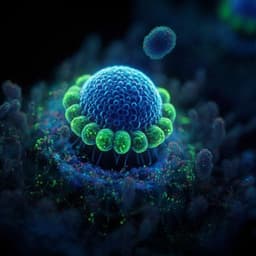
Health and Fitness
The precipitate structure of copper-based antibacterial and antiviral agents enhances their longevity for kitchen use
T. Nishimura, M. Hashimoto, et al.
Discover how a new copper ion-based mixed solution has shown promising results as an antibacterial and antiviral agent for kitchen surfaces. This innovative research indicates that the unique scaly copper deposits contribute to its long-lasting efficacy and safety, conducted by authors Takashi Nishimura, Masami Hashimoto, Kageto Yamada, Ryuji Iwata, and Kazuhiro Tateda.
~3 min • Beginner • English
Introduction
Public awareness of infectious disease risks in food environments increased during the COVID-19 pandemic, prompting the need for preventive measures in food service and healthcare settings. While ethanol, hypochlorite, photocatalysts, and silver/copper ions are used, contamination from uncleaned surfaces remains problematic, and rapid, durable sterilization is needed, including against drug-resistant bacteria such as MRSA. Copper and silver have long-documented antimicrobial properties, with copper acting through membrane damage, reactive oxygen species generation, DNA damage, and photocatalytic effects; antiviral activity against viruses including SARS‑CoV‑2 has also been reported. This study investigates a sprayable, transparent copper ion-based mixed solution (CBMS; Cu2+, Ca2+, Cl−, HPO4 2−; pH ~3) that forms precipitates upon drying. The research question is how the structure and composition of these precipitates (SBSCD) impart rapid and durable antibacterial/antiviral activity on common kitchen and medical substrates, and whether the performance persists over time with acceptable safety.
Literature Review
Historical use of copper/silver vessels for water storage illustrates longstanding antimicrobial applications. Literature reports antibacterial mechanisms of copper via membrane damage, ROS (Fenton-like) generation, DNA damage, and photocatalysis; copper oxide and related compounds show antiviral effects, including activity against SARS‑CoV‑2. Morphology-dependent performance of CuO/Cu2O nanostructures and copper phosphate photocatalysts has been noted, as have surface nanostructure effects on microbial adhesion and antimicrobial efficacy. Prior work suggests monovalent copper species may exhibit stronger immediate antibacterial effects than divalent species, and that photocatalytic performance can diminish over time due to oxidation, aggregation, or crystallinity changes.
Methodology
CBMS composition: Cu2+ 140 mg/L, Ca2+ 0.11 mg/L, Cl− 33 mg/L, HPO4 2− 12.0 mg/L; pH ~3.0. For structural/compositional analysis, substrates (PMMA, SUS304, SUS316L, Zr) were spray-coated with CBMS at 20 mL/m² and dried at room temperature for 8 days to 1 year. Surface morphology and elemental distributions were characterized by SEM (SU‑8000) and SEM‑EDX. For cross-sectional analysis, FIB‑SEM (Hitachi NB5000) microsampling prepared TEM lamellae; STEM‑EDS (JEM‑F200, 200 kV) provided ~5 nm spatial resolution mapping. Electron diffraction identified crystalline phases. XPS microprobe (ULVAC‑PHI; Al Kα; takeoff angle 45°; ~0.8 mm spot; probing depth 4–5 nm) analyzed the outermost layer chemistry over time on SUS304 and SUS316L (PMMA XPS impeded by charging). Antibacterial testing on textiles followed ISO 20743:2013: 1 mL CBMS sprayed on 5×5 cm cotton; dried 24 h; inoculated with diluted bacterial suspensions (1×10^6–3×10^7 CFU/mL), incubated 18 h at 37±2 °C; CFU enumerated to compute antibacterial activity values. Bacteria: Escherichia coli NBRC3301, E. coli O157 RIMD 0509952, Staphylococcus aureus NBRC12732, MRSA IID1677, Pseudomonas aeruginosa NBRC3080, Moraxella osloensis ATCC19976, Klebsiella pneumoniae NBRC13277, Salmonella enterica subsp. Enterica NBRC3313. Antiviral assay on nonporous polyethylene films followed ISO 21702 plaque method: 1 mL CBMS per 5×5 cm film; dried 24 h; 0.4 mL virus inoculum sandwiched to prevent drying; reacted at 25 °C for 15–60 min; recovered and titrated. Viruses: Influenza A/H3N2, Feline calicivirus, SARS‑CoV‑2 wildtype and alpha, delta, omicron variants. Sustainability of antibacterial effect on solid substrates used JIS Z2801 (ISO 22196:2007) film adhesion method with 2 h incubation at 35±1 °C and ≥90% RH. Substrates: PMMA, SUS304, SUS316L (50×50×1 mm); CBMS 20 mL/m²; stored at room conditions for 8 d, 14 d, 3 mo, 6 mo, 1 yr; inoculated with E. coli NBRC3972 or S. aureus NBRC12732; washed, serially diluted, plated, and CFU counted. MRSA simulated hospital test: SUS304, PMMA, PC keyboard coupons (20×20×0.1 mm); UV sterilized; CBMS 20 mL/m²; aged 1–12 weeks; inoculated with MRSA ATCC 43300 (10^8 CFU/mL) for 2 h at 22±2 °C, 30–40% RH; recovered and plated on mannitol salt agar; N=5 per substrate, average from N=3 after outlier exclusion; antibacterial activity value = log CFU (untreated) − log CFU (treated); bactericidal effect threshold ≥3 per EPA. Field trial: Sushi restaurant spray (20 mL/m²) across kitchen/utensils/tables/counters/toilets; ATP hygiene monitoring (Lumitester + Lucipac Pen) on 10×10 cm areas before and 8 h after application.
Key Findings
- SEM revealed micrometre-scale deposits (~5 µm) with varied microstructures, including scaly agglomerates and flower-like precipitates; SEM‑EDX showed Cu, Cl, O in scaly agglomerates and Cu, P, O in flower-like structures, resembling reported Cu2(OH)PO4/CuO morphologies.
- STEM‑EDS on Zr cross-sections detected Cu, P, Cl, O in precipitates, absent in the substrate, indicating similar composition across substrates (PMMA, Zr, SUS304, SUS316L).
- Electron diffraction indicated mixed phases: Cu2P2O7, Cu2O, and Cl2Cu2O in precipitates; low crystallinity with few crystallites.
- XPS on SUS304 precipitates (8 days vs 1 year) detected Cu, Cl, P species. At 8 days, Cu2p3/2 deconvolution area fractions: CuCl 26.9%, CuCl2 18.2%, Cu2O 17.4%, CuO 22.4%; P as (PO4)3− (132.9 eV) and (P2O7)4− (133.8 eV); Cl peaks at 198.4 and 200.8 eV. Over time, Cl content tended to increase and P decreased; Cu (2p) content increased up to 6 months then decreased, consistent with crystallite growth then reduction in apparent surface Cu.
- Across substrates and drying times (8 days to 1 year), SEM‑EDX consistently showed precipitates containing O, Cu, Cl, P; differences in antibacterial performance were attributed to crystallinity/number of crystallites rather than composition. Proposed mechanism includes Cu ion leaching and hydroxyl radical generation via Fenton-like reactions.
- Antibacterial textiles (ISO 20743:2013): Activity values (log reduction) were high. Reported values: E. coli NBRC3301 6.2; E. coli O157 4.7; S. aureus 5.9; MRSA 5.8; P. aeruginosa 6.0; M. osloensis 6.3; K. pneumoniae 6.1; Salmonella enterica subsp. Enterica 3.3. All except S. aureus, O-157, and Salmonella were below detection limits.
- Antiviral (ISO 21702): Activity values ≥3 within short times: Influenza A/H3N2 5.0 (15 min); FCV 3.1 (15 min); SARS‑CoV‑2 wildtype 3.1 (30 min); alpha 3.0 (30 min); delta 4.3 (30 min); omicron 4.9 (60 min).
- Sustainability (JIS Z2801, 2 h exposure): On PMMA, SUS304, SUS316L, antibacterial activity values generally remained ≥2.0 up to 6 months for both E. coli and S. aureus, with slight declines at 3 months and occasional improvement at 6 months; SUS316L trended slightly lower.
- MRSA simulated hospital setting (2 h exposure): SUS304 achieved antibacterial activity ≥3 by 4 weeks; decreased by 8 weeks; ~0.6 at 12 weeks. PMMA ≥3 at 1 week, ≥2 up to 4 weeks, then declined. PC keyboard ≥3 at 1 week, <3 after 2 weeks.
- Field ATP trial in a sushi restaurant: Average ATP decreased from ~5500 RLU before application to ~1000 RLU 8 h after drying, indicating reduced bioburden.
- Safety: Acute oral toxicity TG423 LD50 ≥2000 mg/kg; acute dermal irritation TG404 P.I.I.=0; skin sensitization TG406 not observed; Ames reverse mutation negative; classified as Category 5 or Not Classified under GHS, supporting high safety for intended kitchen applications.
Discussion
The structural and compositional analyses show that CBMS forms SBSCD precipitates comprising mixed copper compounds (Cu2P2O7, Cu2O, Cl2Cu2O, CuO, CuCl/CuCl2) that are strongly bonded to substrates and persist over time. These precipitates facilitate sustained antibacterial/antiviral performance via copper ion release and Fenton-like ROS generation; nanoscale folds (50–100 nm) may promote rapid viral adsorption/inactivation, aligning with observed antiviral efficacy within 15–60 minutes. Temporal XPS trends (increasing Cl, decreasing P; crystallization up to ~6 months followed by reduced apparent Cu signal) correspond to durability data showing maintained or improved antibacterial activity up to 6 months, with later decline. The likely oxidation-driven shift toward CuO and secondary aggregation may reduce efficacy over longer periods, as monovalent species (Cu+, Cu2O, CuCl) are considered more potent initially and photocatalytic copper phosphates can diminish with aging. Substrate-dependent persistence arises from bonding strength and crystallinity differences; strong bonding and suitable nanostructure on SUS304 correlated with superior persistence, including in the hospital simulation. Overall, CBMS coatings offer rapid antiviral action and sustained antibacterial performance for months on common kitchen/medical surfaces, with favorable safety and practical applicability.
Conclusion
This work defines a strongly bonded scaly copper dispersion (SBSCD) precipitate formed by a copper ion-based mixed solution (CBMS) on common substrates and elucidates its mixed-phase composition responsible for durable antibacterial and antiviral activity. CBMS delivers rapid antiviral effects (≥3 log reduction within 15–60 min) and sustains antibacterial activity (often ≥2 log reduction after 2 h exposure) for up to 6 months on PMMA and stainless steels, with strong performance on SUS304. Structural evolution and compositional changes explain the longevity and eventual decline. Toxicological evaluations support safety for kitchen use, and a field trial showed substantial ATP reduction. Continuous or periodic reapplication (e.g., monthly) can maintain performance in practice. Future directions include validating immediate effects with ethanol-addition formulations, conducting 24 h antibacterial assays for direct comparison with standard protocols, optimizing substrate–precipitate bonding and crystallinity, and exploring transition-metal doping of CuO to enhance long-term antibacterial efficacy.
Limitations
- X-ray diffraction of precipitates was not feasible due to low mass; phase identification relied on electron diffraction with limited crystallinity.
- PMMA XPS was hindered by charging, limiting direct surface chemical analysis on that substrate.
- Antibacterial sustainability tests used short 2 h incubation; standard 24 h antibacterial tests were not conducted on coated substrates, limiting comparability to common benchmarks.
- Substrate effects (e.g., SUS304 vs SUS316L) were observed but not fully attributed to specific compositional or interfacial factors.
- Bacterial species and protocol-dependent variability were acknowledged but not systematically dissected.
- Proposed immediate efficacy of ethanol-added CBMS was speculative and not experimentally validated.
- Long-term decline mechanisms (oxidation, aggregation, photocatalytic decay) were inferred from surface analytics and literature but not isolated causally.
Related Publications
Explore these studies to deepen your understanding of the subject.







